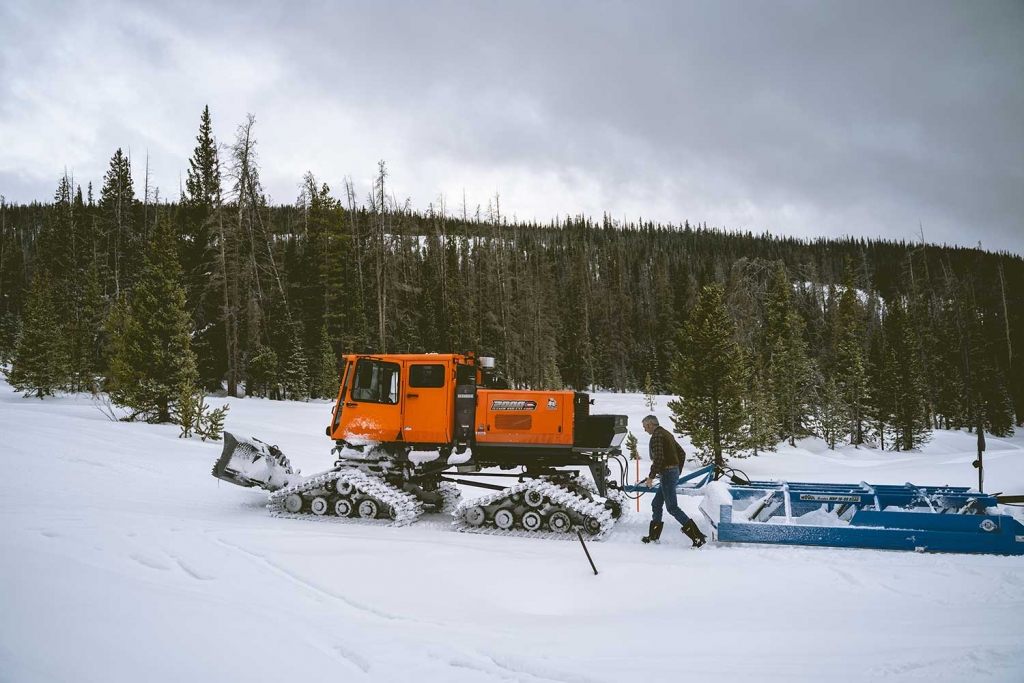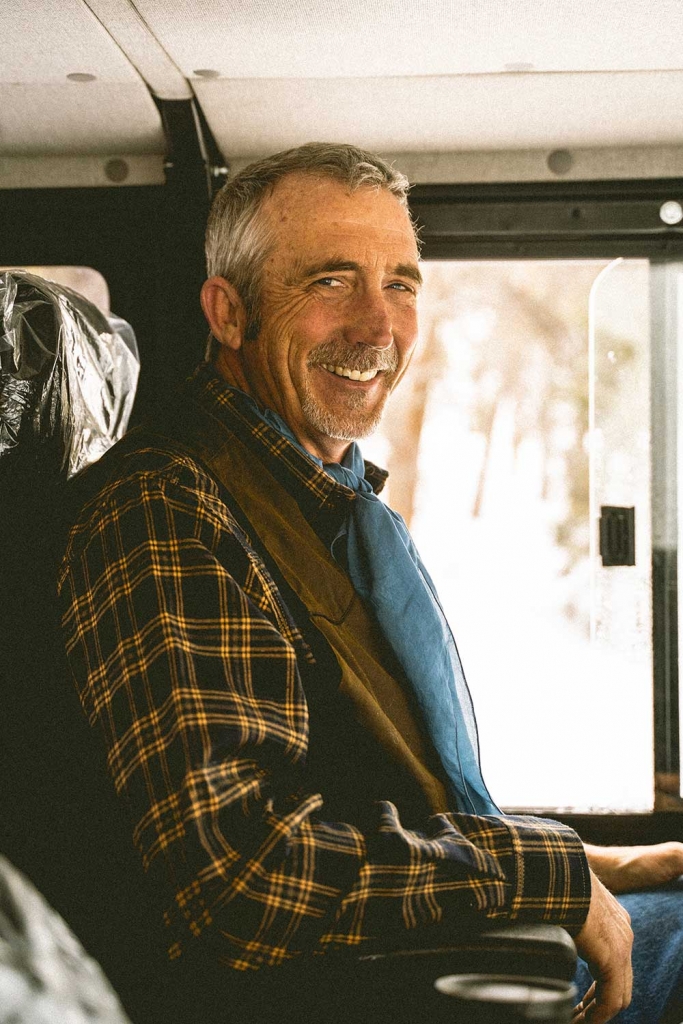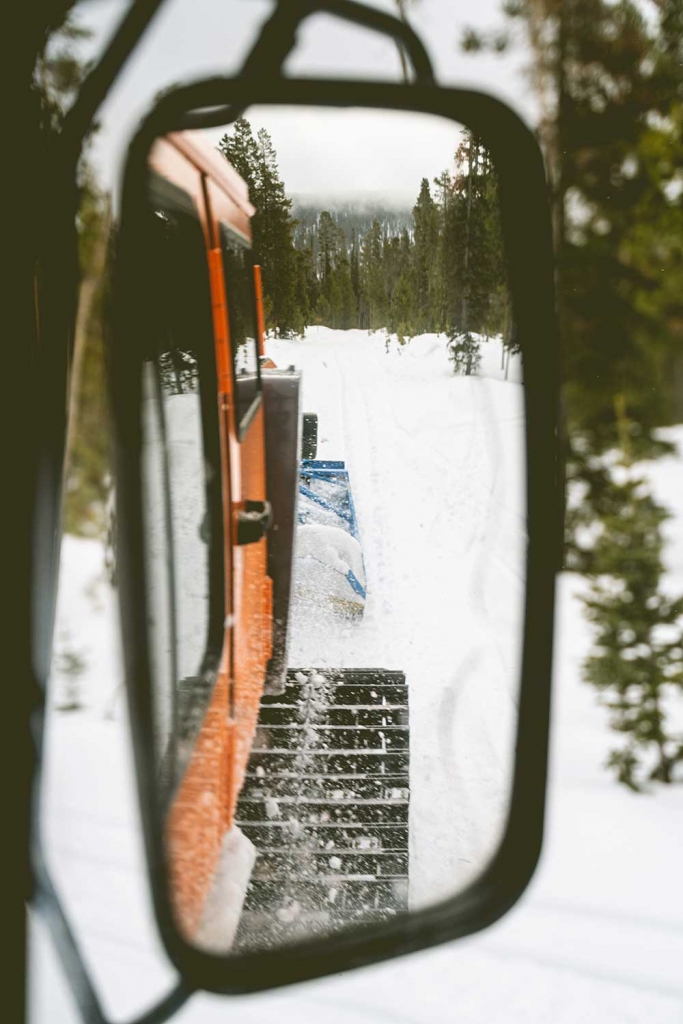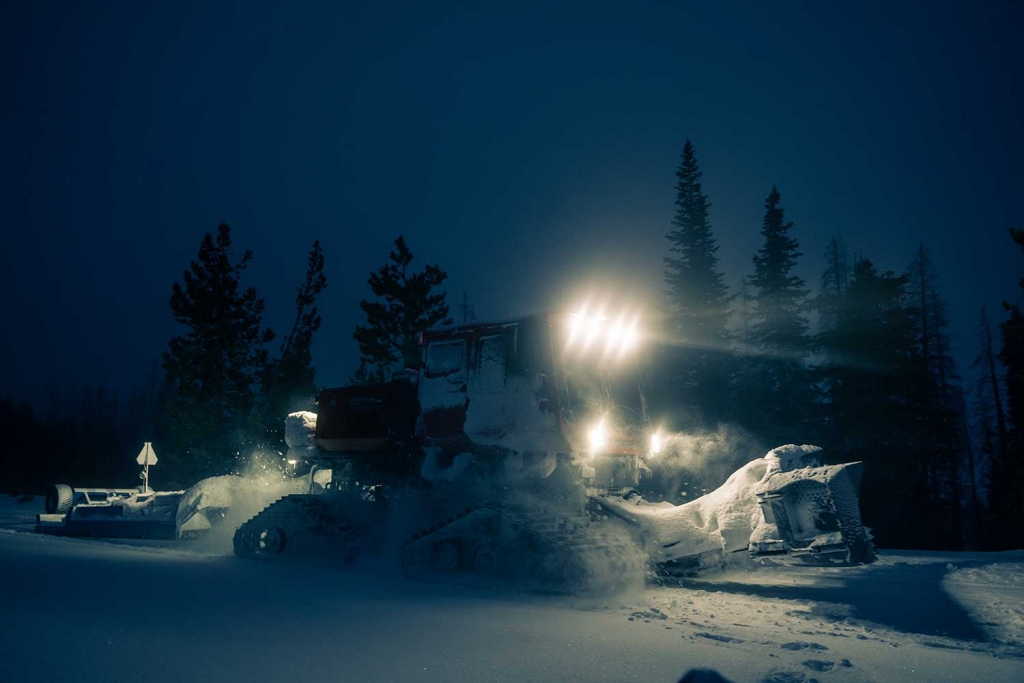Besiders
The Mountain Smoother
Taming the trails of Medicine Bow National Forest, the work of the snow groomers often goes unnoticed. We shed light on the nocturnal labours of Tim Bishop.
Text—Emmalyne Beck
Photos—Mike Penn
As the sun sets, Tim Bishop walks out the front door of his lodge in his trusted flannel work shirt and worn-in snow boots. On frigid nights, he wears thermals under his jeans. Surrounded by the Snowy Range mountains, Bishop carries a warm dinner made by his wife, a Thermos of hot coffee, and water and snacks to last him through the night. One of his two Australian shepherds follows him through the snow to the Tucker Sno-Cat as he embarks on his long night on the trails.

“When I’m out there, and the moon is up, it’s just gorgeous. […] I’m out there by myself, and I’m at home.”
Bishop works as a snow groomer five nights a week during the depths of Wyoming winters, typically from December through March. He is one of three snow groomers in Medicine Bow, Wyoming. Each night of the week they groom the hundreds of miles of trails in Medicine Bow National Forest from sundown until the wee hours of the morning.


Tourism is the second-largest industry in Wyoming, and snowmobiling is a significant attraction. Snowmobilers purchase permits from the state each year to sled Medicine Bow National Forest’s trails. After a full day of snowmobiles passing over them, the trails become rough and require smoothing for the safety and enjoyment of the sledders. Bishop says the state needed someone who lived in the area, was familiar with Medicine Bow National Forest, and could operate big pieces of machinery to work the trails.
“The snowmobilers want a nice trail to go down,” Bishop says. “I will groom, and the snow will be hard. If I don’t groom it, the snow will get these big ruts, and nobody wants to go down them. It’s more dangerous, it tears the snowmobile up, and it is not as enjoyable.”

The snow groomer looms over the icy landscape with its six-metre frame, including a 1.2 m pan and a heated cab. The machine creates an even surface through a process of warming and moving the snow, with the pan smoothing it out at the end. Precariously teetering along narrow strips of land with cliffs on either side requires a balance of artistry and surgical precision. Bishop fluidly manoeuvres the 3.6 m blades across the wild topography, despite the laborious task.

“In some parts of the trail, you can’t go more than four to five miles [six to eight kilometres] an hour,” Bishop says. The longest trail Bishop grooms is 132 km, and takes him 10 to 14 hours to complete.
To become a groomer, Bishop enrolled in a week-long intensive training to learn the basics of the craft. However, like all arts, snow grooming is best learned through practice. Bishop has perfected his approach over the last two years, continuing to learn various nuances of the job.
“I know the trails,” Bishop says. “It was just a matter of learning to drive the groomer.”
Even though Bishop knows the terrain intimately, snow grooming can be dangerous. Furious blizzards, whiteouts, 120 km/h winds, and temperatures dropping to -30 °C are all commonplace on the trails. Bishop says the nights can test your steel as you drive over frozen rivers with water flowing beneath the ice, stare into the green eyes of a stubborn moose, or see mountain lions shred a deer to pieces.

“If you break down, you spend the night or you walk out,” Bishop says. “Normally, you don’t want to leave the snowcat because if you turn it off, you may not get it cranked again up there.”
Bishop says the trails also need to be maintained for search and rescue purposes: “If we don’t have trails groomed to get to those places that people get hurt, we can’t get to them.” While he isn’t on the search and rescue team himself, Bishop says he has pulled a stuck vehicle out of a snowbank and picked up stranded snowmobilers and brought them to safety.


The nights when Bishop is bathed in the luminous glow of the moon and stars are his favourites. On top of the mental exercise of navigating the snow groomer through the unmarked trails, he listens to audiobooks to pass the time.
“I learn a lot while I’m up there,” he says.
While the solitary work can be lonely, Bishop is never truly alone. Each night he alternates bringing one of his dogs, Roper and Magnum, leaving the other with his wife at their lodge. This ride-along tradition was actually not originally Bishop’s idea. The first time he went grooming, Roper and Magnum trailed their owner across the frozen landscape.
“I just happened to be turning around and found them [the dogs]. I didn’t know they were following me. They went 50 km before I picked them up. If I hadn’t found them where I did, they would have had to go 100 km,” Bishop says, laughing. “They were so sore; they could hardly walk the next day. They are much happier in the cab.”

Bishop and his wife Debbie have lived in Medicine Bow for 18 years. They run Medicine Bow Lodge & Adventure Guest Ranch, which accepts visitors during the spring, summer, and fall. As Bishop prepares his lodges for the winter, he gears up to groom the trails. Bishop says he enjoys the peace of the winter after a busy guest season.
“In the summer, I’m with people from 6 o’clock in the morning to 8 or 9 o’clock at night, seven days a week, from the end of May to the end of October,” he says. “In the winter, it’s a nice break. I’m not with people. It’s quiet. I can think. I can listen to books. It’s a whole different experience for me.”
Emmalyne Beck is passionate about writing the stories of those often disregarded. She believes that the greatest honour is to hear the stories of others. A native of the southeastern United States, she delights in digesting alluring words, experiencing new cultures, marvelling at nature, listening to bountiful rain, and basking in the gift of community.
Never Miss Another Issue
Two issues per year
25% OFF previous issues
Free Shipping in Canada